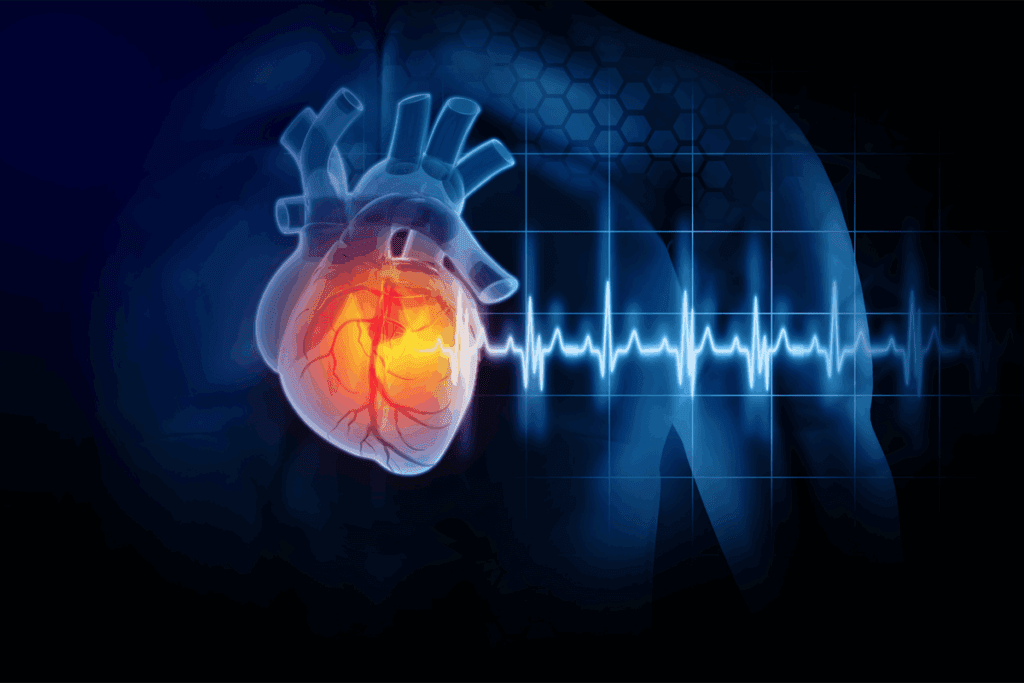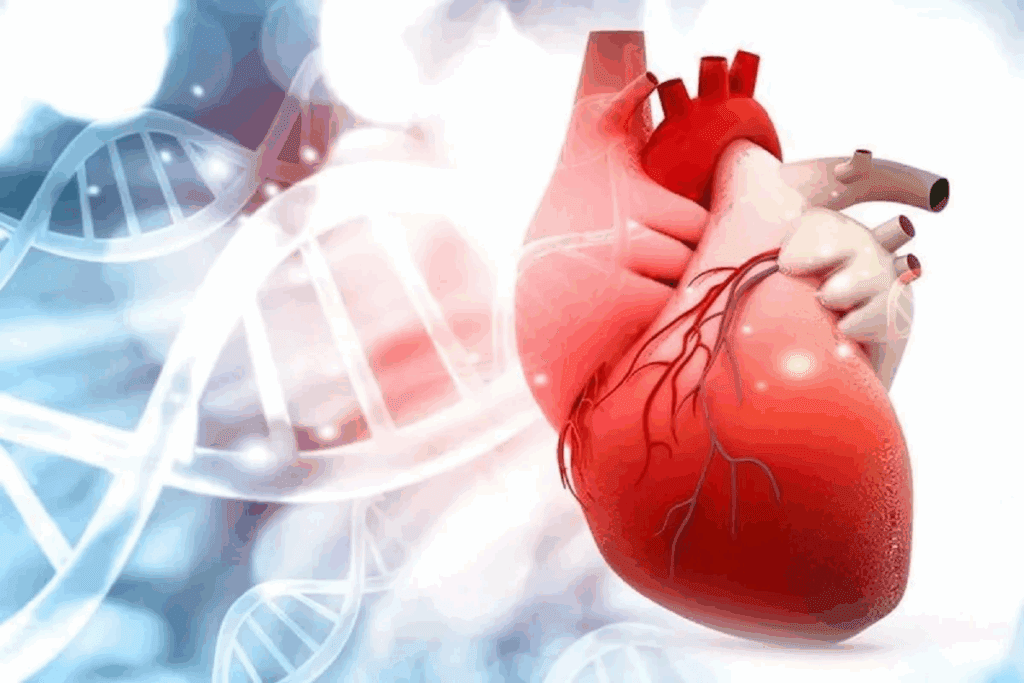
It’s important to know the signs of cardiac conduction disorders. Quick and right treatment can stop serious problems. At Liv Hospital, we focus on you, using the latest in heart care.
Discover heart conduction disorders treatment options and key warning symptoms.
The CDC says heart disease is the top killer in the U.S. There are many ways to treat heart conduction disorders. These include medicines, pacemakers, and new procedures.

To understand heart conduction disorders, we need to know about the heart’s electrical system. This system is complex and controls the heartbeat. It makes sure the heart pumps blood well throughout the body.
The heart’s electrical system sends out electrical impulses that control the heartbeat. It includes the SA node, AV node, bundle of His, bundle branches, and Purkinje fibers. Each part is vital for a coordinated heartbeat.
The SA node starts the electrical impulses. These impulses go through the atria, making them contract. Then, they reach the AV node, which delays them slightly. The impulse then goes to the ventricles through the bundle of His and bundle branches. The Purkinje fibers lead to ventricular contraction.
A conduction disorder happens when the heart’s electrical system doesn’t work right. This can cause arrhythmias or irregular heartbeats. These disorders can affect any part of the electrical system, from the SA node to the Purkinje fibers.
There are different reasons for conduction disorders. They can include problems with impulse generation, blockages, or re-entry circuits. Knowing these reasons helps doctors diagnose and treat these disorders.
There are several common types of conduction abnormalities:
Each condition has its own features and needs different treatments.

Knowing the symptoms of heart conduction disorders is key. It helps you know when to get medical help. These disorders affect how the heart sends electrical signals, leading to various symptoms.
People with heart conduction disorders often notice general warning signs. These include fatigue, dizziness, and syncope (fainting). These happen because the heart can’t pump enough blood, leading to less oxygen for the body.
Fatigue makes you feel very tired and weak. Dizziness makes you feel like you might fall. Syncope, or fainting, is a sudden loss of consciousness and is very serious.
Intraventricular Conduction Delay (IVCD) is when the heart’s ventricles have trouble sending signals. Symptoms include palpitations and shortness of breath. This is because the heart can’t pump blood well.
Some people with IVCD don’t show symptoms. Regular check-ups are important to catch it early. If symptoms do appear, they can really affect your life and need medical attention.
Right Ventricular Conduction Delay is when the right ventricle has trouble sending signals. It causes palpitations and fatigue, similar to IVCD. It can also cause chest pain or difficulty breathing when you’re active.
If you’re experiencing these symptoms, see a doctor. They can help figure out what’s wrong and how to treat it.
Diagnosing conduction system abnormalities starts with tests like electrocardiograms and advanced methods. It’s key to manage heart conduction disorders well.
Electrocardiograms (ECGs) are key in finding heart rhythm disorders. They show the heart’s electrical activity. This helps doctors spot conduction system abnormalities.
Important ECG signs include:
Understanding ECG results needs knowing the heart’s electrical system well.
More tests than ECGs can give deeper insights into cardiac conduction delays and other issues. These include:
These tests help find complex conduction system problems and guide treatment.
It’s vital to assess the risk of sudden cardiac events in patients with disorders of the heart conduction system. This means looking at the chance of arrhythmias or cardiac arrest. Considered factors include:
By accurately rating risk, doctors can make plans that fit each patient’s needs. This could stop serious events.
Effective treatment for heart conduction disorders needs a deep understanding of the condition and patient needs. We know each patient is different. So, treatment must be made just for them.
The type and how severe the heart conduction disorder is key in picking the right treatment. For some, a pacemaker is needed. Others might just need medicine or more complex treatments like catheter ablation.
Choosing a treatment means weighing its benefits against its risks. This involves talking a lot with the patient and doctor. They consider the patient’s health, the disorder’s nature, and how the treatment might affect their life.
For example, pacemaker implants are usually safe but carry risks like infection or device reaction. Medications can also have side effects that need to be managed.
The main goals of treating heart conduction disorders are to improve symptoms, enhance life quality, and lower the risk of complications. The outcomes depend on the treatment and the patient’s condition.
By choosing and tailoring treatment carefully, we can greatly improve patient results. Pacemaker therapy can fix a normal heart rhythm. CRT can make the heart work better and lessen heart failure symptoms.
In conclusion, treating heart conduction disorders is very individualized. It needs a detailed approach that looks at the disorder type, patient needs, and the risks and benefits of different treatments.
Medication therapy is key in managing cardiac conduction delays. It helps regulate heart rhythm and improve function. We’ll look at the different medications, how they work, and why it’s important to check their effectiveness.
Antiarrhythmic medications are vital in treating cardiac conduction delays. They change the heart’s electrical properties to stabilize rhythm. There are several types, each working in a unique way.
Classes of Antiarrhythmic Medications:
Beta blockers and calcium channel blockers are key in managing cardiac conduction delays. Beta blockers lower heart rate and contraction force, reducing oxygen demand. Calcium channel blockers block calcium ions, causing blood vessels to widen and heart workload to decrease.
| Medication Class | Mechanism of Action | Clinical Effect |
| Beta Blockers | Reduce sympathetic stimulation | Decrease heart rate and contractility |
| Calcium Channel Blockers | Inhibit calcium ion influx | Vasodilation and reduced cardiac workload |
It’s vital to monitor how well medication therapy works for cardiac conduction delays. Regular check-ups, ECGs, and Holter monitoring help assess treatment success. This allows for any needed adjustments.
Understanding medication mechanisms and benefits helps healthcare providers create personalized treatment plans. This approach improves outcomes in managing cardiac conduction delays.
Pacemakers have changed how we treat heart problems. They help people with certain heart issues. This procedure makes sure the heartbeat is regular.
There are many pacemakers for different heart problems. Choosing the right one depends on the heart issue, the patient’s health, and their lifestyle.
Some common pacemakers include:
| Type of Pacemaker | Description | Indications |
| Single-Chamber | One lead to pace either atrium or ventricle | Certain types of bradycardia |
| Dual-Chamber | Two leads to pace both atrium and ventricle | More complex conduction disorders |
| Biventricular | Used in CRT to synchronize ventricular contractions | Heart failure with ventricular dyssynchrony |
The pacemaker implantation is done under local anesthesia. The patient is awake but relaxed. A small incision is made in the chest. The leads are then guided into the heart using fluoroscopy.
Recovery is usually quick. Most patients can go back to normal activities in a few days. It’s important to follow the doctor’s advice on care and follow-up.
“The implantation of a pacemaker can significantly improve the quality of life for patients with conduction blockades, allowing them to lead more active and normal lives.”
— Medical Expert, Cardiologist
Managing a pacemaker long-term means regular check-ups. These ensure the device works right and settings are adjusted as needed. Patients should also know how to monitor their condition and report any changes or concerns.
Understanding pacemakers helps patients make better choices for their heart health. This can improve their outcomes.
Catheter ablation is a big step forward in heart care. It’s a minimally invasive procedure that fixes the heart’s electrical issues. This method uses energy to destroy the bad pathways in the heart.
A cardiologist uses thin, flexible tubes called catheters to reach the heart during the procedure. They then send energy to the heart area with the problem. This energy, like heat or cold, kills the bad tissue, fixing the heart’s rhythm.
Advanced imaging helps find the exact spot in the heart. This makes sure the treatment works well. It’s a curative solution for many people.
Not everyone with heart issues is right for catheter ablation. Doctors look at many things before deciding. They check the patient’s history, the heart problem, and test results.
Those who don’t get better with medicine or have bad side effects are chosen. Before the procedure, patients get ready. This includes stopping some medicines and not eating or drinking.
Recovery time after catheter ablation varies. Most stay in the hospital for a day. Some might feel pain or see bruises where the catheter was, but these go away soon.
How well the treatment works depends on the heart problem and the patient’s health. For many, it greatly reduces or stops heart rhythm problems. It makes life better. Aftercare is key to check how the heart is doing and handle any issues.
Managing complex heart conduction disorders often requires new treatments like CRT and surgery. Cardiac resynchronization therapy (CRT) is a cutting-edge treatment. It has shown great promise in managing heart failure and conduction disorders.
CRT devices help synchronize the heartbeat, improving heart function in some patients. These devices send electrical impulses to both ventricles, making them contract at the same time. To implant a CRT device, a procedure is done under local anesthesia and with fluoroscopy guidance.
Choosing the right patient for CRT is key for success. Factors like heart failure severity, left bundle branch block, and overall health are considered. By picking the right candidates, we can get the most out of CRT.
ICDs are vital for patients at risk of dangerous heart rhythms. These devices can give a shock to fix a heartbeat when they spot dangerous rhythms. ICDs are very important for those with a history of ventricular tachycardia or fibrillation.
The procedure for ICDs is similar to CRT, with leads in the heart and a generator under the skin. Regular check-ups are needed to make sure the device works right and to adjust settings if needed.
Surgery may be needed for complex conduction disorders. This can include fixing anatomical issues or removing scar tissue that causes arrhythmias. Surgery is considered when other treatments don’t work or aren’t right.
The choice to have surgery depends on the patient’s health, how severe their condition is, and the risks and benefits of the surgery. We carefully look at each patient to find the best surgical option.
Managing heart conduction disorders needs a full plan. This includes different treatments and ongoing care. Knowing the symptoms, diagnosis, and treatments helps patients live better.
We talked about several ways to treat heart conduction disorders. These include medicines, pacemakers, catheter ablation, and cardiac resynchronization therapy. Each method is important for managing the disorder, and the right one depends on the type and how severe it is.
Living with these disorders means keeping a close eye on your health. Patients need to work with their doctors to manage their condition and avoid problems. This way, people with heart conduction disorders can have active and happy lives.
Handling heart conduction disorders is a long journey. It takes patience, commitment, and the right treatment. With the right care, patients can lessen their symptoms, avoid complications, and feel better overall.
Symptoms include fatigue, dizziness, and shortness of breath. They can also cause syncope. The exact symptoms depend on the disorder type.
Doctors use electrocardiograms (ECGs) and advanced tests. They also check for sudden cardiac event risks. Accurate diagnosis is key for good treatment.
Treatments include medicines and pacemakers. Other options are catheter ablation, CRT, ICDs, and surgery. The right treatment depends on the disorder and patient needs.
These medicines regulate heart rhythm by targeting specific pathways. Beta blockers and calcium channel blockers help manage symptoms and slow the heart rate.
Pacemakers regulate heart rhythm by sending electrical impulses. The type of pacemaker chosen depends on the patient’s condition.
Catheter ablation uses energy to destroy abnormal heart pathways. It’s used for certain arrhythmias and conduction disorders.
CRT devices improve heart function and reduce symptoms. They’re used in heart failure and certain conduction disorders.
ICDs monitor heart rhythm and deliver shocks to restore normal rhythm. They prevent sudden cardiac death.
Surgery, like maze surgery, can treat complex disorders. But, it has risks and is considered for those who haven’t responded to other treatments.
Effective management includes medicines, lifestyle changes, and regular check-ups. Working with a healthcare team is essential for a personalized plan.
A conduction disorder disrupts the heart’s electrical impulses, causing abnormal rhythms.
IVCD symptoms include fatigue, shortness of breath, and dizziness. Symptoms vary by individual and condition severity.
They disrupt the heart’s electrical activity, causing irregular beats and reduced function. This can lead to serious complications.
National Center for Biotechnology Information. (2025). 7 Effective Treatments for Heart Conduction Disorders and. Retrieved from https://www.ncbi.nlm.nih.gov/pmc/articles/PMC11395937)
Subscribe to our e-newsletter to stay informed about the latest innovations in the world of health and exclusive offers!
WhatsApp us